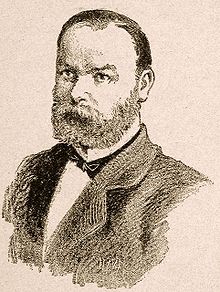This is an old revision of this page, as edited by Mohonu (talk | contribs) at 08:03, 2 September 2008 (new section). The present address (URL) is a permanent link to this revision, which may differ significantly from the current revision.
Revision as of 08:03, 2 September 2008 by Mohonu (talk | contribs) (new section)(diff) ← Previous revision | Latest revision (diff) | Newer revision → (diff)| This translation system has been deprecated in favour of WP:TRANSLATION. |
|

Carl Christian Koldewey (born October 26 1837 in Bücken near Hoya, Germany; died May 17 1908 in Hamburg) was a German Arctic explorer.
Life and career
Koldewey was the son of the merchant Johann Christian Koldewey and his wife Wilhelmine Meyer. Koldewey enrolled as a sailor in 1853 immediately after grammar school at Clausthal. At 22 he attended the naval school in Bremen, where he was among Arthur Breusing's best pupils. Later he went to sea again but returned to naval school in 1861. After becoming a captain, Koldewey studied mathematics, physics, and astronomy at the universities of Hannover and Göttingen between 1866 and 1867.
Expeditions
Through his teacher Breusing and encouraged by August Petermann Koldewey was given the leadership of the first Northpole expedition as captain of ship Grönland. He had the choice of either advancing northwards as far as possible along Greenland's east coast or to reach so-called Gillis-Land by travelling around Spitzbergen. But adverse conditions and strong ice floes prevented him from reaching both destinations. Finally he reached his northmost latitude of 81°5' near Spitzbergen and returned.
From 1869 to 1870 he was captain of the Germania and the leader of another expedition to Greenland and to the Arctic Sea which intended to penetrate into the Arctic central region. It was equipped with the propeller steamboat Germania and the sailing ship Hansa under captain Paul Friedrich Hegemann. Six scientists joined the expedition: astronomer and physicists Karl Nikolai Jensen Börgen and Ralph Copeland, zoologist, botanist and physician Adolf Pansch, and surveyor Julius von Payer. On the Hansa travelled physician and zoologist R. Buchholz and geologist Gustav Carl Laube.
The expedition left Bremerhaven on June 15 1869. Already on July 20 both ships were separated. The Hansa was crushed by the ice on October 19 1869 and the crew saved itself on an ice floe. Meanwhile the Germania reached Sabine Island on August 5 1869. From there the task of mapping out of the coast between 73° and 77° northern latitude was undertaken by taking measurements from the ship or using sleighs and whalers. This work was a continuation of Edward Sabine's 1823 expedition. Trying to reach the North pole, the Germania reached its northernmost latitude 75°30"N on August 14 northeast of Shannon Island, where they had to return on account of lack of leads in the ice. Payer carried out the mapping of Shannon island while the astronomers took latitude measurements on it. A wintering camp was established at Sabine island from August 27 1869 to July 22 1870. Advancing inland using sleighs, the islands and coast of Greenland were mapped. Further investigations were carried out that provide an insight into the magnitude of Greenland's mountains and glaciers. However, the actual highlight and most considerable geographical achievement of the expedition was the discovery and investigation of Kaiser-Franz-Joseph-Fjord.
Later work
After finishing the expeditions Koldewey worked as a writer and took part in scientific publications. Since 1871 he worked at the German naval observatory in Hamburg, whose Nautical instruments department he took over in 1875. On July 31 1905 he retired as an admiralty's director. One of his nephews, Robert Koldewey (1855-1925), became a famous archaeologist and architecture historian.
Posthumous honors
Places named after Carl Koldewey:
- Koldewey-Station, a German research station in Ny-Ålesund on Spitzbergen. It is run by the Alfred-Wegener Institute.
- Koldewey Island (Остров кольдевея) in Franz-Joseph-Land, Russian Arctic.
External links
All links are in German.
- Template:PND
- Biography at the Alfred-Wegener Institute
- Koldeweys Incidents during the 2. German North pole expedition (1869/70)